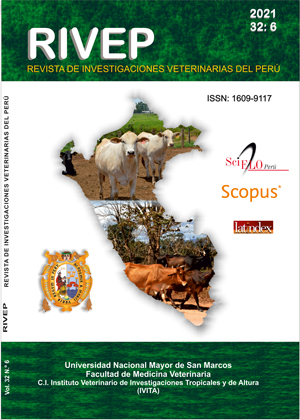First approximation of optimum stocking rate in guinea pigs grazing during the raining season in the Peruvian highlands
DOI:
https://doi.org/10.15381/rivep.v32i6.21679Keywords:
guinea pigs, grazing, optimum stocking rate, associate pasture, Peruvian highlandsAbstract
The present study carried out a first approximation of the optimum stocking rate in guinea pigs grazing during the rainy season in the Peruvian highlands, using an associated perennial pasture composed of Lolium multiflorum, Lolium perenne, Dactylis glomerata, Trifolium pratense, Trifolium repens y Medicago sativa based on individual body weight gain and per area, feed intake, feed conversion, pasture yield, production costs and cost benefit ratio. In total, 132 15-day-old male G guinea pigs were used in a randomized complete block design with three 60-day fattening cycles as a block and four treatments corresponding to stocking rates of 400 (T1), 500 (T2), 600 (T3) and 700 (T4) guinea pigs/ha/year. It was used areas of 200 m2 of pasture where groups of 8, 10, 12 and 14 guinea pigs grazed in T1, T2, T3 and T4, respectively. The results showed that there was no effect of the stocking rate on individual body weight gain, feed intake, feed conversion and pasture performance yield (>0.05). The effects on the gain per unit area and cost benefit ratio (p<0.05) were a direct and expected consequence of the different number of animals between stockings. The range of stocking rates was insufficient to determine an optimal stocking rate, so it is tentatively suggested to use the stocking rate of 700 guinea pigs/ha/year, as it is the stocking rate that allows more animals per area with productive parameters similar to lower stocking rates and better economic parameters.
Downloads
Downloads
Published
Issue
Section
License
Copyright (c) 2021 Liz Anaya L., Amparo Huamán C., Felipe San Martín H., Miguel Ara G., Fernando Carcelén C., Ronald Jiménez A.

This work is licensed under a Creative Commons Attribution 4.0 International License.
AUTHORS RETAIN THEIR RIGHTS:
a. Authors retain their trade mark rights and patent, and also on any process or procedure described in the article.
b. Authors retain their right to share, copy, distribute, perform and publicly communicate their article (eg, to place their article in an institutional repository or publish it in a book), with an acknowledgment of its initial publication in the Revista de Investigaciones Veterinarias del Perú (RIVEP).
c. Authors retain theirs right to make a subsequent publication of their work, to use the article or any part thereof (eg a compilation of his papers, lecture notes, thesis, or a book), always indicating the source of publication (the originator of the work, journal, volume, number and date).










